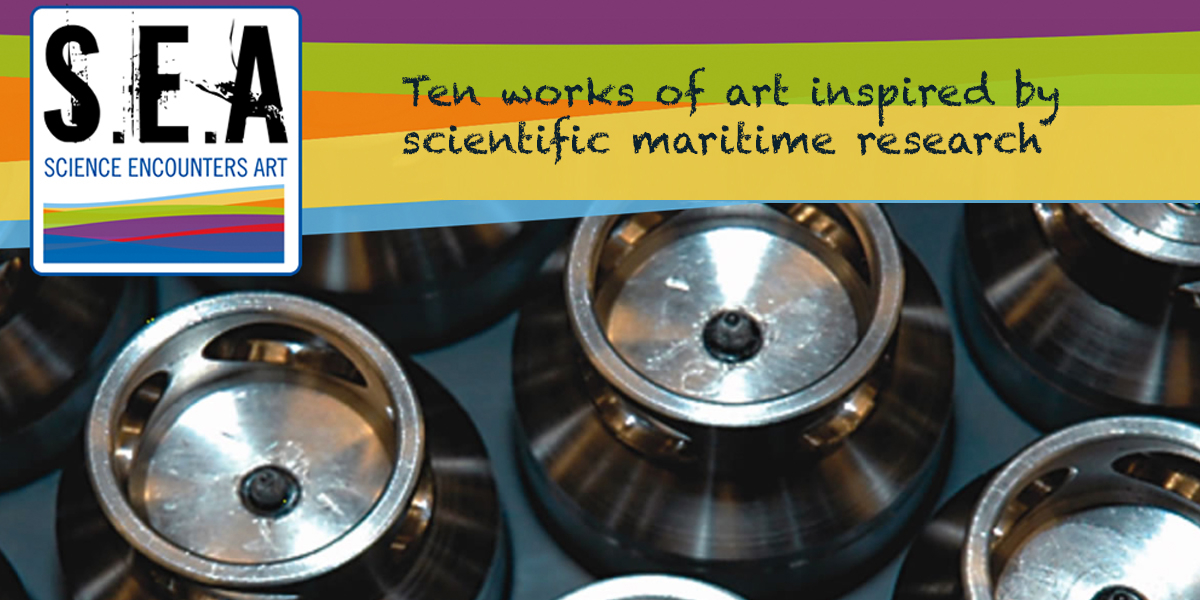Dr. Femke de Jong
‘Ocean currents are the engine of the climate’
Physical oceanographer Dr Femke de Jong studies the various currents in the oceans. ‘Ocean currents transport heat and nutrients across a large part of the Earth. An example of an important current is the Gulfstream, which brings water from Florida to the north. Without this current it could be quite a bit colder in the Netherlands. In the areas around Greenland, the water from the tropical Atlantic Ocean cools and sinks, after which it flows back to the south in the deep ocean.’
From floating buoys to the seafloor
‘Although we have known about where the major ocean currents are for a while, we still know very little about how these currents change over time. We use various methods to measure the strength and direction of the current and the temperature and salinity of the water it transports. In the northern part of the Atlantic Ocean we now have hourly measurement of these currents from instruments that are attached to cables anchored to the ocean floor with weights and held upright by buoys. By trying to understand how and especially why currents change, we hope to understand future changes too. That is because subtle changes, for example due to more ice melting around the north pole, could have major consequences for our climate.’
Insulating blanket
‘One of those subtle changes can be caused by meltwater that flows off Greenland. The majority of the water flows along the east coast of Greenland. We would like to know how and where the water “leaks away” into the open ocean. In an extreme scenario, the lighter, freshwater remains in large quantities on top of the heavier seawater and acts as an insulating blanket. As a result of this the saltwater around Greenland can no longer sink into the deep ocean and that could ultimately disrupt the transport of heat to the north.’
Underwater weather
‘If you draw all the subtle ocean currents on a map with different colours for the different temperatures or salt levels, then you obtain a sort of weather map of rotating high and low-pressure areas. In the oceans, these are larger and smaller vortices that spread heat, salt and nutrients across the earth. With our measurements, we hope to obtain a realistic picture about the role all these ocean currents and eddies play in the slowly but surely changing climate.’
Read more +Research interest
My research is mostly based in the North Atlantic Subpolar Gyre, investigating processes like dense water overflows, deep convection and boundary current – interior exchange. I am particularly interested in the relation between these processes and the Atlantic Meridional Overturning Circulation (AMOC).
I am a sea going oceanographer with a preference for hydrographic and Lagrangian observations, though I often use models and theory to better understand these observations.
Vidi project: From ice to deep ocean, where does the freshwater go?
Deep water formation in the ocean basins around Greenland is an important process within the Atlantic circulation. It is the vertical link between the northward flow of warm, buoyant water in the upper ocean and the southward flow of cold, dense water in the deep ocean. This deep water formation is a consequence of the weak local stratification and strong surface buoyancy forcing. Input of freshwater, which has a much lower density then seawater, is predicted to increase the stratification to the point where deep water formation stops and the Atlantic circulation slows down.
In climate models, the input of freshwater from the Arctic and Greenland’s melting ice cap slows down the Atlantic Ocean circulation significantly, with consequences for climate over north-western Europe. However, the range in predicted responses of the circulation to increasing freshwater input is large. Model predictions rely on the models’ representation of freshwater exchange between the Greenland boundary current system and the deep ocean. These processes occur on scales smaller than the typical model grid scale, making results highly dependent on model resolution.
Observational studies of freshwater exchange have focused on the west Greenland shelf, where ocean eddies have been observed to transport freshwater from the boundary current into the interior. Multiple lines of evidence suggest that freshwater exchange occurs along the 3700 km long east Greenland shelf as well, but this process is yet unstudied. This project aims to study key areas and mechanisms of liquid freshwater exchange around Greenland. And to quantify the impact of these freshwater fluxes on the ocean circulation and evaluate models on their ability to represent the exchange and impact.
The fieldwork of 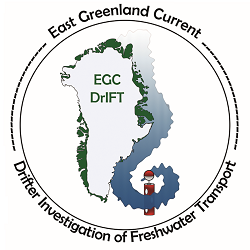 the project consists of surface drifter deployments on the East Greenland shelf in the summers of 2019 and 2020. The trajectories of the drifters will show possible pathways of freshwater out of the boundary current towards the convective regions. We will also study stratification and the impact of freshwater on convection in the Irminger Sea.
the project consists of surface drifter deployments on the East Greenland shelf in the summers of 2019 and 2020. The trajectories of the drifters will show possible pathways of freshwater out of the boundary current towards the convective regions. We will also study stratification and the impact of freshwater on convection in the Irminger Sea.
NACLIM/OSNAP Irminger Current array
Oceanographic research carried out in the North Atlantic Ocean is of great importance to understand the role of the ocean in our climate and future climate change. As part of an international collaboration between the US, UK, Germany, France, the Netherlands, Canada and China the Netherlands Institute for Sea Research (NIOZ) deployed a moored array on the western flank of the Mid Atlantic Ridge. These 5 moorings (four tall and one short) sample the northward flow of warm, saline water in the Irminger Current in the upper water column as well as the dense North East Atlantic Deep Water (also called Iceland Scotland Overflow Water) in the lower water column.
The complete OSNAP array will provide a high-resolution time series of full water-column transs-baisn fluxes of volume, heat and freshwater. This will provide a measure of the strength and variability of the Atlantic Meridional Overturning Circulation in the Subpolar North Atlantic.
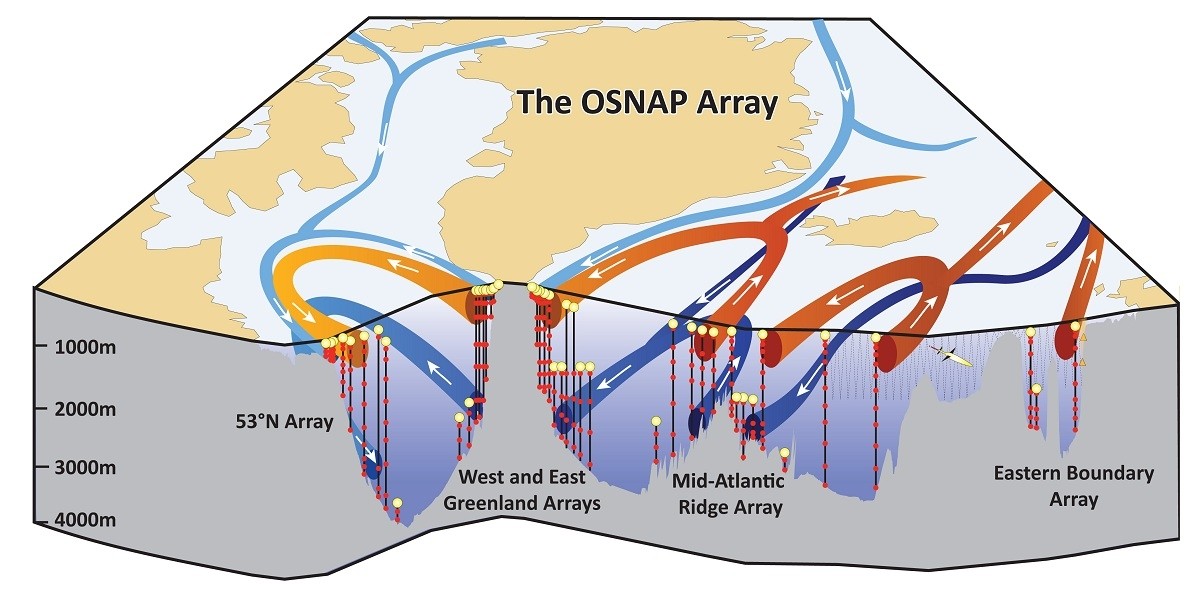
This video shows our research on the currents in the subpolar North Atlantic. More information can be found on the OSNAP webpage at www.o-snap.org. Here you can find video's of the NACLIM project.
Pathways to Denmark Strait
The water mass that overflows the shallow sill of Denmark Strait (aptly named Denmark Strait Overflow Water or DSOW) is the densest constituent of North Atlantic Deep Water, which forms the deep southward return flow in the Meridional Overturning Circulation. There are two main hypothesized sources of DSOW, the Greenland Sea via the East Greenland Current, or the Iceland Sea via the North Icelandic Jet (or possibly a both).
RAFOS floats were deployed in the Iceland Sea to elucidate the sources of DSOW and the pathways of dense water to the Denmark sill. The first batch of 26 floats was deployed in July 2013, the second batch of 26 floats was deployed in July 2014. These floats can be tracked using the signals of six sound sources moored in the Iceland Sea.
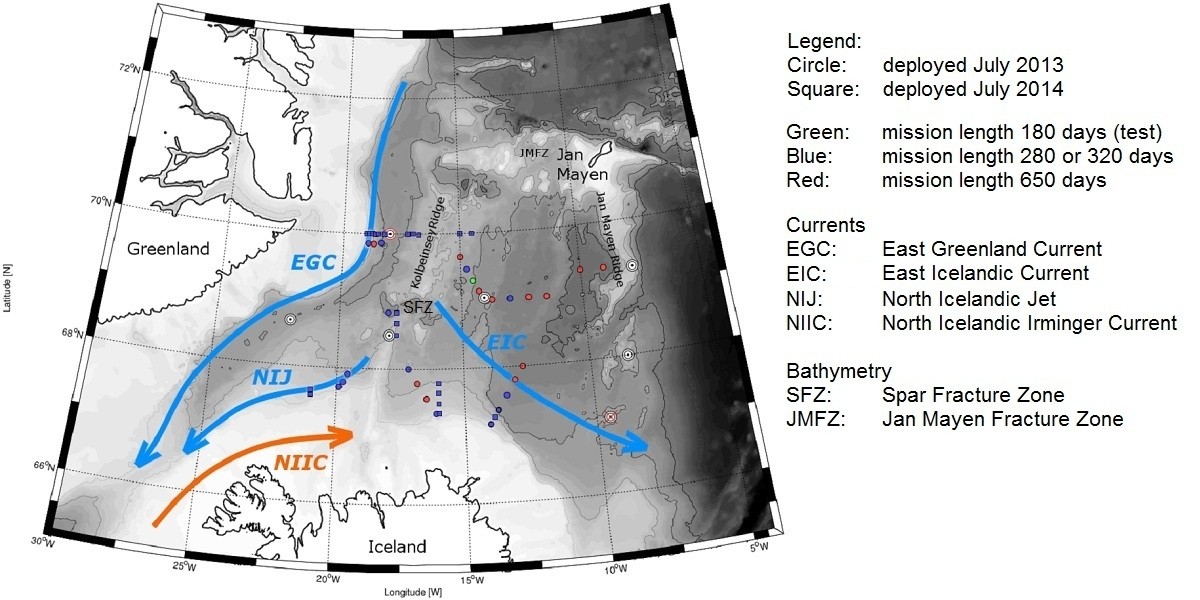
(Funded by NSG grant# 1259210: de Jong & Bower, in collaboration with Henrik Soiland of the Institute of Marine Research, Bergen, Norway.)
Meso-scale eddies in the Labrador Sea
The Labrador Sea is one of few regions where deep convection occurs. During strong winters the surface waters are cooled to the point where they become dense enough to sink and mix with deeper waters. This process forms a cold water mass called Labrador Sea Water that extends from the surface down to 1 to 2 km deep. During spring and summer the central Labrador Sea restratifies. The warm, saline water responsible for the restratification is thought to originate from the Irminger Current along the west Greenland shelf. Due to a sudden steepening of the shelf the current becomes unstable and sheds warm-core eddies. These eddies can transport heat and salt to the interior basin.
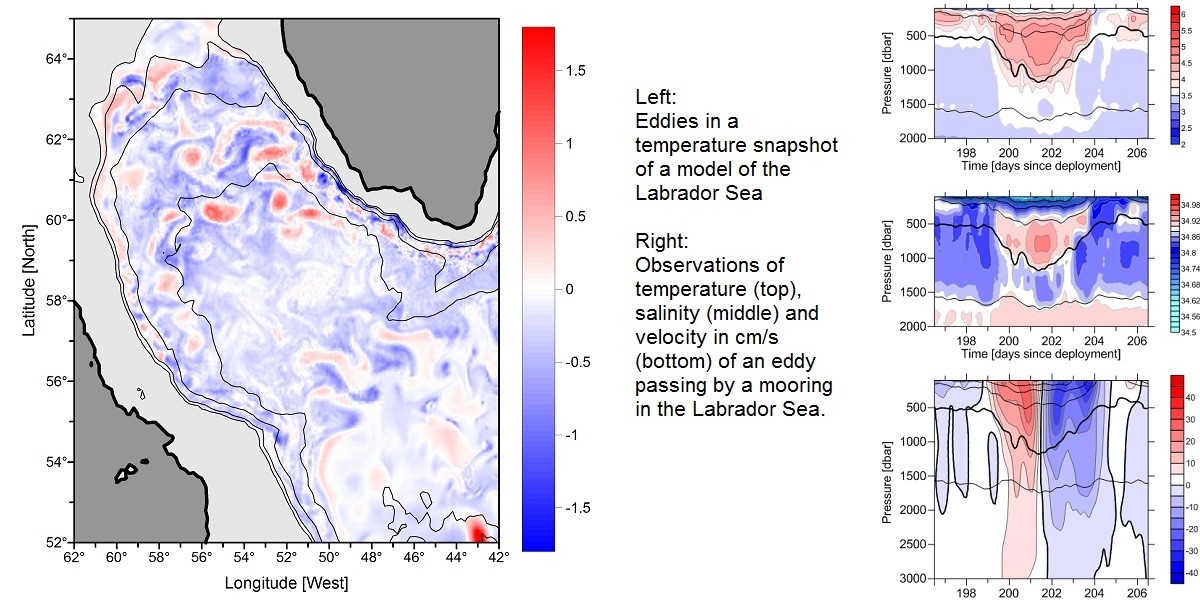
Using observations from a mooring we estimated the heat transport of eddies into the Labrador Sea. We found that these eddies vary strongly in size, with radii from 11 to 35 km. Seasonally varying properties add to the large range in transport estimates.
Linked news
Linked blogs
NIOZ publications
-
2023
Duyck, E.; de Jong, M.F. (2023). Cross‐shelf exchanges between the East Greenland shelf and interior seas. JGR: Oceans 128(7): e2023JC019905. https://dx.doi.org/10.1029/2023jc019905Fu, Y.; Lozier, M.S.; Biló, T.C.; Bower, A.S.; Cunningham, S.A.; Cyr, F.; de Jong, M.F.; deYoung, B.; Drysdale, L.; Fraser, N.; Fried, N.; Furey, H.H.; Han, G.; Handmann, P.; Holliday, N.P.; Holte, J.; Inall, M.E.; Johns, W.E.; Jones, S.; Karstensen, J.; Li, F.; Pacini, A.; Pickart, R.S.; Rayner, D.; Straneo, F.; Yashayaev, I. (2023). Seasonality of the Meridional Overturning Circulation in the subpolar North Atlantic. Commun. Earth Environ. 4(1). https://dx.doi.org/10.1038/s43247-023-00848-9
-
2022
de Jong, M.F. (2022). De (bijna) onbereikbare oceaan. Ned. Tijdschr. Natuurkd. Juli: 16-19Desbruyères, D.G.; Bravo, E.P.; Thierry, V.; Mercier, H.; Lherminier, P.; Cabanes, C.; Biló, T.C.; Fried, N.; de Jong, M.F. (2022). Warming‐to‐cooling reversal of overflow‐derived water masses in the Irminger Sea during 2002‐2021. Geophys. Res. Lett. 49(10): e2022GL098057. https://dx.doi.org/10.1029/2022gl098057Duyck, E.; Gelderloos, R.; de Jong, M.F. (2022). Wind‐driven freshwater export at Cape Farewell. JGR: Oceans 127(5): e2021JC018309. https://dx.doi.org/10.1029/2021jc018309Fried, N.; de Jong, M.F. (2022). The role of the Irminger Current in the Irminger Sea northward transport variability. JGR: Oceans 127(3): e2021JC018188. https://dx.doi.org/10.1029/2021jc018188Sterl, M.F.; de Jong, M.F. (2022). Restratification structure and processes in the Irminger Sea. JGR: Oceans 127(12): e2022JC019126. https://dx.doi.org/10.1029/2022jc019126
-
2021
Berx, B.; Volkov, D.; Baehr, J.; Baringer, M.; Brandt, P.; Burmeister, K.; Cunningham, S.; de Jong, M.; de Steur, L.; Dong, S.; Frajka-Williams, E.; Goni, G.; Holliday, P.; Hummels, R.; Ingvaldsen, R.; Jochumsen, K.; Johns, W.; Jónsson, S.; Karstensen, J.; Kieke, D.; Krishfield, R.; Lankhorst, M.; Larsen, K.; Le Bras, I.; Lee, C.; Li, F.; Lozier, S.; Macrander, A.; McCarthy, G.; Mertens, C.; Moat, B.; Moritz, M.; Perez, R.; Polyakov, I.; Proshutinsky, A.; Rabe, B.; Rhein, M.; Schmid, C.; Skagseth, Ø.; Smeed, D.; Timmermans, M.-L.; von Appen, W.-J.; Williams, B.; Woodgate, R.; Yashayaev, I. (2021). Climate-relevant ocean transport measurements in the Atlantic and Arctic Oceans, in: Kappel, E.S. et al. Frontiers in ocean observing: Documenting ecosystems, understanding environmental changes, forecasting hazards. Oceanography, Suppl. 34(4): pp. 10-11. https://dx.doi.org/10.5670/oceanog.2021.supplement.02-04Duyck, E.; de Jong, M.F. (2021). Circulation over the South‐East Greenland Shelf and potential for liquid freshwater export: a drifter study. Geophys. Res. Lett. 48(5): e2020JB020886. https://doi.org/10.1029/2020gl091948Li, F.; Lozier, M. S.; Bacon, S.; Bower, A. S.; Cunningham, S. A.; de Jong, M. F.; deYoung, B.; Fraser, N.; Fried, N.; Han, G.; Holliday, N. P.; Holte, J.; Houpert, L.; Inall, M. E.; Johns, W. E.; Jones, S.; Johnson, C.; Karstensen, J.; Le Bras, I. A.; Lherminier, P.; Lin, X.; Mercier, H.; Oltmanns, M.; Pacini, A.; Petit, T.; Pickart, R. S.; Rayner, D.; Straneo, F.; Thierry, V.; Visbeck, M.; Yashayaev, I.; Zhou, C. (2021). Subpolar North Atlantic western boundary density anomalies and the Meridional Overturning Circulation. Nature Comm. 12: 3002. https://hdl.handle.net/10.1038/s41467-021-23350-2Li, F.; Lozier, M.S.; Holliday, N.P.; Johns, W.E.; Le Bras, I.A.; Moat, B.; Cunningham, S.A.; de Jong, M.F. (2021). Observation-based estimates of heat and freshwater exchanges from the subtropical North Atlantic to the Arctic. Prog. Oceanogr. 197: 102640. https://dx.doi.org/10.1016/j.pocean.2021.102640
-
2020
de Jong, M.F.; de Steur, L.; Fried, N.; Bol, R.; Kritsotalakis, S. (2020). Year‐round measurements of the Irminger Current: Variability of a two‐core current system observed in 2014–2016. JGR: Oceans 125(10). https://doi.org/10.1029/2020jc016193Grist, H.; Ballester, J.; de Jong, M.F.; Langehaug, H.R.; Olsen, S.M.; Swingedouw, D. (2020). Decadal predictions to climate services: how understanding climate change in the arctic can support climate adaptation decision-making across the Northern Hemisphere, in: Heininen, L. (Ed.) et al. Arctic Yearbook 2020.Le Bras, I.A.; Straneo, F.; Holte, J.; de Jong, M.F.; Holliday, N.P. (2020). Rapid export of waters formed by convection near the Irminger Sea's western boundary. Geophys. Res. Lett. 47(3): e2019GL085989. https://dx.doi.org/10.1029/2019gl085989Pacini, A.; Pickart, R.S.; Bahr, F.; Torres, D.J.; Ramsey, A.L.; Holte, J.; Karstensen, J.; Oltmanns, M.; Straneo, F.; Le Bras, I.A.; Moore, G.W.K.; de Jong, M.F. (2020). Mean conditions and seasonality of the West Greenland boundary current system near Cape Farewell. J. Phys. Oceanogr. 50(10): 2849-2871. https://doi.org/10.1175/jpo-d-20-0086.1Payne, M.; Keenlyside, N.S.; Bearzotti, C.; de Jong, M.F.; Fritz, J.-S.; Grist, H.; Ketelhake, S.; Meller, L. (2020). Forecasting fish distribution and abundance in the Atlantic Ocean: The challenge of balancing exploitation and sustainability: Policy brief. Thesis. Zenodo: [s.l.]. 10 pp. https://doi.org/10.5281/zenodo.4289934Payne, M.; Keenlyside, N.S.; Bearzotti, C.; de Jong, M.F.; Fritz, J.-S.; Grist, H.; Ketelhake, S.; Meller, L. (2020). Forecasting fish distribution and abundance in the Atlantic Ocean: The challenge of balancing exploitation and sustainability: Blue-Action policy briefing. Blue-Action: [s.l.]. 10 pp. https://doi.org/10.5281/zenodo.4289934Saberi, A.; Haine, T.W.N.; Gelderloos, R.; de Jong, M.F.; Furey, H.; Bower, A. (2020). Lagrangian perspective on the origins of Denmark Strait Overflow. J. Phys. Oceanogr. 50(8): 2393-2414. https://doi.org/10.1175/jpo-d-19-0210.1
-
2019
Josey, S.A.; de Jong, M.F.; Oltmanns, M.; Moore, G.K.; Weller, R.A. (2019). Extreme variability in Irminger sea winter heat loss revealed by ocean observatories initiative mooring and the ERA5 reanalysis. Geophys. Res. Lett. 46(1): 293-302. https://dx.doi.org/10.1029/2018GL080956Lozier, M.S.; Li, F.; Bacon, S.; Bahr, F.; Bower, A.S.; Cunningham, S.A.; de Jong, M.F.; de Steur, L.; deYoung, B.; Fischer, J.; Gary, S.F.; Greenan, B.J.W.; Holliday, N.P.; Houk, A.; Houpert, L.; Inall, M.E.; Johns, W.E.; Johnson, H.L.; Johnson, C.; Karstensen, J.; Koman, G.; Le Bras, I.A.; Lin, X.; Mackay, N.; Marshall, D.P.; Mercier, H.; Oltmanns, M.; Pickart, R.S.; Hawkins, A.L.; Rayner, D.; Straneo, F.; Thierry, V.; Torres, D.J.; Williams, R.G.; Wilson, C.; Yang, J.; Yashayaev, I.; Zhao, J. (2019). A sea change in our view of overturning in the subpolar North Atlantic. Science (Wash.) 363(6426): 516-521. https://dx.doi.org/10.1126/science.aau6592van der Boog, C.G.; de Jong, M.F.; Scheidat, M.; Leopold, M.F.; Geelhoed, S.C.V.; Schulz, K.; Dijkstra, H.A.; Pietrzak, J.D.; Katsman, C.A. (2019). Hydrographic and biological survey of a surface‐intensified anticyclonic eddy in the Caribbean Sea. JGR: Oceans 124(8): 6235-6251. https://doi.org/10.1029/2018JC014877
-
2018
de Jong, M.F.; Oltmanns , M.; Karstensen, J.; de Steur, L. (2018). Deep convection in the Irminger Sea observed with a Dense Mooring Array. Oceanography 31(1): 50-59. https://dx.doi.org/10.5670/oceanog.2018.109de Jong, M.F.; Søiland, H.; Bower, A.S.; Furey, H. (2018). The subsurface circulation of the Iceland Sea observed with RAFOS floats. Deep-Sea Res., Part 1, Oceanogr. Res. Pap. 141: 1-10. https://doi.org/10.1016/j.dsr.2018.07.008
-
2017
Lozier, M.S.; Bacon, S.; Bower, A.S.; Cunningham, S.A.; de Jong, M.F.; de Steur, L.; de Young, B.; Fischer, J.; Gary, S.F.; Greenan, B.J.W.; Heimbach, P.; Holliday, N.P.; Houpert, L.; Inall, M.E.; Johns, W.E.; Johnson, H.L.; Karstensen, J.; Li, F.; Lin, X.; Mackay, N.; Marshall, D.P.; Mercier, H.; Myers, P.G.; Pickart, R.S.; Pillar, H.R.; Straneo, F.; Thierry, V.; Weller, R.A.; Williams, R.G.; Wilson, C.; Yang, J.; Zhao, J.; Zika, J.D. (2017). Overturning in the Subpolar North Atlantic Program : a new international ocean observing system. Bull. Am. Meteorol. Soc. 98(4): 737-752. https://dx.doi.org/10.1175/BAMS-D-16-0057.1
-
2016
de Jong, M.F.; Bower, A.S.; Furey, H.H. (2016). Seasonal and Interannual Variations of Irminger Ring Formation and Boundary–Interior Heat Exchange in FLAME. J. Phys. Oceanogr. 46: 1717-1731. dx.doi.org/10.1175/JPO-D-15-0124.1de Jong, M.F.; de Steur, L. (2016). Strong winter cooling over the Irminger Sea in winter 2014–2015, exceptional deep convection, and the emergence of anomalously low SST. Geophys. Res. Lett. 43: 7106–7113. dx.doi.org/10.1002/2016GL069596
